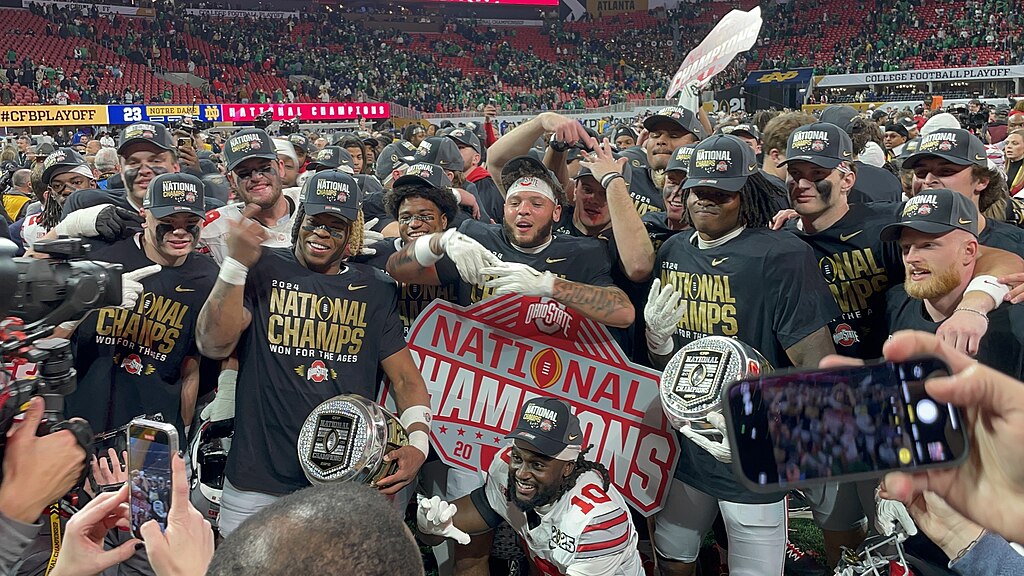THE Ohio State University won the National Championship against the Fighting Irish on January 20. With a final score of 34 to 23 in the Buckeyes’ favor, the game was rarely exciting and rarely close.
The game marked the first time since 2008 that back-to-back championships lacked the presence of a Southeastern Conference (SEC) team. The Buckeyes looked to capture their 9th National Championship; the Fighting Irish looked to capture their 12th. This marks the second season that the College Football Playoff (CFP) played with a 12-team format. For the first nine years of the CFP, the Playoff hosted just the top four seeded teams from the regular season, but since 2023 the legendary collegiate championship has invited three times that number to marked effect.
The final four teams this year initially found themselves slotted fifth through eighth. Under the old format, these teams wouldn’t have even competed for the Championship. As an Ohio State student I have to wade through a heroic amount of bias to even get close to a fair opinion, but in my experience, fans much prefer an extra chance for their hometown heroes.
So the system changed and OSU won. But how did this tripling even come around in the first place? You could argue that the increased capacity of the CFP means better games, better advantages for winning the conferences and better opportunities for small schools. But in truth, as many things do, it comes down to the desire for better money.
Each CFP Tournament game is played with heightened odds – a loss means sudden death for a team and their entire fanbase. The networks, shareholders, and companies running ads most of all, love how many people are watching football. Before the expansion, the playoffs ended in early January. Now, additional weeks increase the bottom line for all involved.
Who else might love the format? Sportsbooks, of course. Live and legal in 38 states + DC, sports betting dominates our media landscape. Every third ad on TV invites you to download FanDuel or BetMGM or DraftKings: all begging for a chance to take your money. In November 2024, sports betting hit a new monthly revenue record of $1.6 billion against $15 billion in handle, a number that only continues to rise.
Sports betting and football have gone hand in hand for decades, but its widespread legalization in the United States marks a dramatic societal shift. In 2018 the United States Supreme Court struck down a 1992 law that barred most states from legalizing sports betting. The gambling industry pushed to strike down the law by pointing out how illegal betting already occurred in dangerous, unregulated environments. People will always want to gamble, so shouldn’t we make sure they do so safely? And think of the tax revenue. For most state legislators, it comes down to a very easy yes.
You can see the repercussions of these laws everywhere. Instead of managing the existing betting, it has introduced the habit to a whole new demographic. According to a NCAA study, 52% of those who watched sports betting ads said that the ads made them more likely to gamble. Among high risk gamblers, that number rose to 80%. Gambling help centers receive three times as many calls as they did before the 2018 legalization. And while the age of gambling holds steady at 18 in most states, since when has an age minimum ever stopped anyone from doing what they want? Especially when that thing makes money.
The massive amounts of money involved in sports betting has led to a wave of exposés on players and referees engaged in sports betting, most notoriously on their very own games. Why shouldn’t a quarterback act like an amoral Wall Street insider when the money makes itself? The harsh legal penalties might discourage some, but for many greed rules supreme.
The industry only continues to grow, with ever-larger amounts of money changing hands faster and faster. As the CFP adds three weeks of football, it adds three weeks of profit at the expense of young adults. Just as Ohio State kicks that final field goal of the game, Las Vegas cash flows free and wild.


Leave a Reply